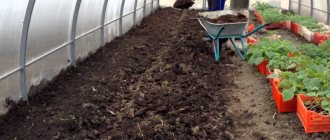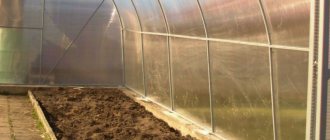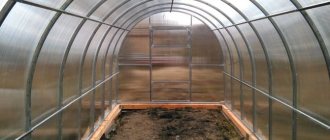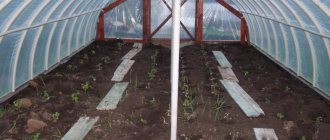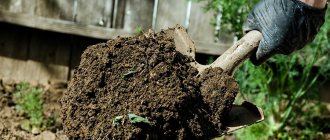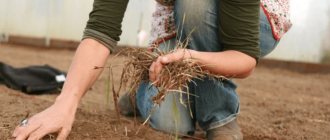Greenhouses for vegetables are empty and “dirty”, with a full range of pests and plant diseases, depleted soil, spilled with small plant debris.
Vegetables can suffer from various diseases due to sharp changes in day and night temperatures, dense planting, excess soil and air moisture, as well as overfeeding with nitrogen fertilizers.
If you do not treat the greenhouse in the fall, in the hope that the frost will disinfect the greenhouses, then already at the beginning of summer the plants planted here will be damaged by pests and diseases.
Soil depletion
Planting monocultures in a greenhouse leads to a decrease in soil fertility. Tomatoes, peppers, and cucumbers take away valuable minerals and trace elements that cannot be replenished with fertilizing. Warm and humid climates encourage the growth of weeds, which also deplete the soil.
The greenhouse substrate gradually compacts, becomes water- and airtight, and loses its looseness. Plant roots receive insufficient oxygen and develop poorly. The application of mineral fertilizers increases the acidity of the soil mixture.
Over time, the soil in the greenhouse becomes oversaturated with heavy metals that are part of fungicides and insecticides, and the remnants of undecomposed mineral fertilizers. Vegetables grown on such land contain an increased amount of nitrates and can no longer be called environmentally friendly.
Using a biological product for rooting seedlings
Before planting, it is advisable to treat vegetable seedlings with HelpRost rooting agent. Its advantages are as follows: the drug accelerates the formation and growth of roots, improves the survival rate of seedlings during planting and replanting.
To treat the roots of seedlings, 35 ml of the drug is diluted in 10 liters of water. The working solution is poured into each well when planting.
The same solution can be used for watering - every 10-15 days. Liquid consumption – 150 ml per plant.
Remember that proper soil preparation in a greenhouse is the key to a rich harvest. Delight your family with fresh, environmentally friendly vegetables and herbs grown with your own hands!
Soil contamination by diseases and pests
The lack of crop rotation causes the accumulation of spores of pathogenic fungal diseases in the soil: late blight, fusarium wilt, cladosporiosis, and various rots. The soil in the greenhouse is not sufficiently frozen, and the causative agents of bacterial infections do not die during the winter. On contaminated soils, plants quickly become diseased in cold or rainy weather.
Insect pests are easily infested in greenhouses; heat and high humidity contribute to their rapid reproduction. Whiteflies, aphids, thrips, and spider mites can survive the winter if the soil does not freeze to -15˚C.
Video: Strategy for preparing a greenhouse for wintering
Sowing green manure
It’s not for nothing that green manure is called “green manure”: it enriches the soil with essential nutrients, improves its structure and suppresses the growth of weeds. With the right choice and annual sowing of green manure, you can get rid of pathogens that accumulate in the soil. The best crops for a greenhouse where tomatoes grow are legumes, lupine, mustard, phacelia, oats, rapeseed, alfalfa, and rye. They can be sown in the spring, as soon as the soil in the greenhouse has thawed and the temperature at night does not drop below 0°C.
- What are the best green manures to sow in the garden and greenhouse in the spring?
The main task of green manure is to enrich the soil with nitrogen and organic matter. Most often, green manures are legumes and cereals, as well as their mixtures with other plants. These green fertilizers restore the composition of the soil, but not all of them can be sown in unheated soil.
2-3 weeks before planting the main crop, green manure is mowed and embedded into the ground at a shallow depth using a flat cutter or hoe. Then it is advisable to water the ground with a solution of an EM preparation: for example, Baikal EM 1 or Ekomik Urozhainy. This will accelerate the decomposition of organic matter, attract earthworms, and as a result, the humus content in the soil will increase.
- EM drugs: benefits and applications
What are “effective microorganisms” and why are they in the garden?
Step-by-step instruction
The event is recommended to be held once every 2 years. In practice, due to the high complexity of the procedure, such soil replacement is carried out with a significant reduction in yield.
Prepare the soil mixture: take peat, turf soil, humus or well-rotted compost and coarse sand in a ratio of 4:3:2:1. Add 2–3 kg of wood ash. The soil is thoroughly mixed.
In the greenhouse, crop residues are removed and weeds are removed. The walls and roof of the structure are washed with soapy water. Using a shovel, remove the top part of the soil 10–12 cm thick, or 20–30 cm in case of severe damage. The substrate is taken outside the greenhouse and scattered on beds where it is not planned to grow crops of the nightshade or pumpkin family. The bottom layer of soil is spilled with bleach or diluted copper sulfate (20 g per 10 liters of water).
The prepared substrate is evenly distributed around the entire perimeter of the greenhouse. To increase the beneficial microflora in the soil, it is watered with a solution of “Fitosporin”, “Baikal-M”.
Replacing the top layer of soil in a greenhouse is the most effective way to improve the structure and fertility of the soil and get rid of bacterial and viral infections. The method is used in case of severe damage by parasitic insects and to destroy wintering pests.
How to determine that the soil in a GREENHOUSE needs to be replaced?
It's time to change the soil if:
- Planted plants begin to get sick even at the development stage. The constant fight against diseases practically does not solve the problem, despite the use of modern chemicals.
- The plantings develop poorly, bloom poorly, and drop their ovaries. In general, if crops in a greenhouse look unhealthy and there are no signs of disease, then this indicates depletion of the soil mixture.
- The plants produce a meager harvest, although they develop normally. Even if you take good care of them, following all the rules, poor contaminated soil does not allow you to produce a good harvest.
- The soil becomes covered with plaque and is infested with parasites that attack the crops. When the number of insects is large, and pathogens are just waiting for suitable conditions to infect the plants, the problem can only be solved by replacing the top layer.
- Active application of organic matter does not help enrich the soil; plantings still develop poorly.
These signs indicate that it is pointless to grow anything in a greenhouse without replacing the top layer. With the onset of autumn, a layer at least 30 cm thick must be removed. It is advisable to collect fresh soil from a deciduous forest, or purchase it and add the necessary components.
Option two - replacing greenhouse soil
First, the top layer of soil (20-25 cm thick) is removed from the greenhouse. To this place add a small layer of 12-15 cm of fresh soil (imported or from your own plot from a place where vegetables have not been grown before). Just in case, it is disinfected - spilled with a solution of potassium permanganate or Bordeaux mixture. Afterwards, the nutrient composition is poured on top in a layer of 7-10 cm. It varies depending on the crop being grown.
- So, for cucumbers - this is garden soil, peat, manure, sawdust (2: 1: 1: 1).
- Tomatoes will benefit from a light nutrient composition of garden soil, manure and river sand (2:1:1).
- The soil for peppers must contain humus (1 part) and river sand (1 part).
- Root crops will grow well in loose, nutrient-rich soil with good moisture permeability, so adding river sand (1.5 parts) and humus (1 part) is also indispensable here.
- Cabbage will produce rich harvests on soil that is generously amended with humus or compost (at least 1 part). At the end, the soil is dug up - a fresh, disease- and pest-free nutrient cushion is ready.
WHAT TO DO WITH OLD SOIL?
If you are sure that there are no serious diseases in the soil, it can be used to form warm beds or plant less demanding crops or those plants with which greenhouse vegetables do not have common diseases and pests - for example, berries such as serviceberry and chokeberry.
Ground change frequency
To effectively combat late blight and other infectious diseases, it is necessary to “cut off” the old soil in the greenhouse and fill in new soil in its place. It is recommended to change the soil in the greenhouse once every 2 years. This is due to the penetration of pathogenic microorganisms into the greenhouse, which are carried with clothes and shoes. Since the conditions in the greenhouse are favorable, they quickly multiply and spread, which leads to low yields or death of plants.
Before renewing the soil, it is necessary to remove the remains of old plants and weeds. Remove 5-10 cm of soil, but if it is heavily damaged by pests, it is recommended to change 20-30 cm of soil. At the same time, it is not necessary to buy a special soil mixture, and you can prepare the soil yourself. Such soil should consist of 50% peat, 20% humus or compost, 10% river sand and 10% turf soil.
You may also find the following materials useful:
- What to do with plant debris in the garden
- Causes of aphids and preventing their spread
- What is a smart garden without the hassle
- Country secrets: how to grow a large crop in a small area
- Should I leave the green manure to grow over the winter or is it better to bury it?
Using the drug MycoHelp
The biological product MikoHelp will help improve the soil before planting seedlings. To do this, you need to dilute 20-40 g (1-2 sachets) of the product in 10 liters of water.
The soil is treated by spraying. The resulting solution should be enough for an area of 100 sq.m.
Then the soil should be loosened with a rake. You can sow seeds or plant seedlings immediately after treating the soil.
Properties of the biological product:
- treatment and prevention of fungal diseases (antagonist fungi suppress the development of phytopathogens that cause root and stem rot);
- stimulation of root system growth;
- increasing the area of absorption of batteries;
- retaining moisture in the soil.
How to get rid of late blight?
Many gardeners are seriously concerned about the question: how to treat late blight in a greenhouse in the spring?
Late blight is every gardener’s nightmare. This is a fungus that affects all nightshade crops - tomatoes, potatoes, eggplants, peppers. Late blight can destroy any plant from roots to fruits.
The fruits of a plant affected by late blight cannot be eaten , and the plant itself must be immediately pulled out and burned to prevent the disease from spreading to healthy bushes. However, such methods often do not bring results: once late blight appears, it can destroy half the crop.
Important! Prevention of late blight should begin in the fall. After harvesting, you need to carefully eliminate all plant remains and burn them outside the garden.
If an outbreak of late blight does occur in the greenhouse, you need to treat the soil with a special preparation - “Fitosporin”. Before the next planting of plants, treatment should be carried out at least 3 times.
Biological method
Biological products have a delicate effect on the soil, disinfect and improve the quality of the soil. Proven drugs:
- powder or tablets “Glyokladin”;
- Golden autumn "Fitosporin-M";
- "Trichoderm";
- "Pseudobacterin";
- "Planriz";
- "Baktofit".
Biological preparations contain antibiotics, so they must be used strictly according to the instructions, having first checked the expiration dates. The indicated doses cannot be lowered or increased categorically. Active oxygen kills bacteria. For additional soil disinfection, water after ozonation and enrichment of the area with oxygen through an ozonizer are suitable.
Tips from experienced gardeners for processing a greenhouse in the fall
Let's listen to the practical advice of experienced gardeners:
- when deep autumn sets in, it is better to leave all the windows and doors open for a while: the frosty air will kill any accidentally surviving pests. In addition, the temperature inside the room will be equal to the outside, and this will eliminate the appearance of ice and snow will not be able to damage the roof of the building;
- if winters are snowy, then it is better to strengthen the greenhouse with supports;
- It is better to make roof supports T-shaped, this will protect the roof during heavy snowfalls;
- Before using any disinfectant, you should study how it affects the soil;
- Don’t forget to fertilize, because plants pull everything out of the soil in one season!
There are also ready-made sulfur bombs that are easy to use PHOTO: oteplicah.ru
Experienced gardeners recommend clearing snow from the roof in winter, and closer to spring bringing it into the beds inside PHOTO: i.ytimg.com
Fertilizing the greenhouse: we do it in the fall
Applying fertilizers before winter will help prepare the soil for the next planting season. In the fall, organic matter is added in the form of peat, manure, sawdust, and compost. To understand what should be added, check the acidity of the soil.
Manure also causes concern among many, since late blight may appear as a result. PHOTO: teplicno.ru
In the fall, superphosphate and potassium are added. Wood ash contains many microelements. During the winter period, improvements will occur in the soil due to the introduction of such additives, so do not neglect this important point.
Related article:
Do-it-yourself greenhouse made from scrap materials. Design features, the use of various materials to create a reliable load-bearing frame and high-quality cladding, step-by-step installation instructions with rules for choosing a suitable location on a plot of land are in our publication.
